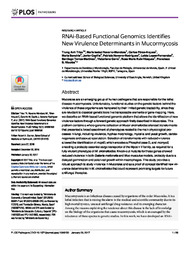Título :
RNAi-Based Functional Genomics Identifies New Virulence Determinants in Mucormycosis |
Autor :
Trieu, Trung Ahn
Navarro-Mendoza, María Isabel 
Pérez-Arques, Carlos 
Sanchis, Marta
Capilla, Javier 
Navarro Rodríguez, Patricia 
López-Fernández, Loida 
Torres-Martinez, Santiago 
Garre, Victoriano 
Ruiz-Vázquez, Rosa María
Nicolas, Francisco Esteban  |
Editor :
Public Library of Science |
Departamento:
Departamentos de la UMH::Producción Vegetal y Microbiología |
Fecha de publicación:
2017-01-20 |
URI :
https://hdl.handle.net/11000/35254 |
Resumen :
Mucorales are an emerging group of human pathogens that are responsible for the lethal disease mucormycosis. Unfortunately, functional studies on the genetic factors behind the virulence of these organisms are hampered by their limited genetic tractability, since they are reluctant to classical genetic tools like transposable elements or gene mapping. Here, we describe an RNAi-based functional genomic platform that allows the identification of new virulence factors through a forward genetic approach firstly described in Mucorales. This platform contains a whole-genome collection of Mucor circinelloides silenced transformants that presented a broad assortment of phenotypes related to the main physiological processes in fungi, including virulence, hyphae morphology, mycelial and yeast growth, carotenogenesis and asexual sporulation. Selection of transformants with reduced virulence allowed the identification of mcplD, which encodes a Phospholipase D, and mcmyo5, encoding a probably essential cargo transporter of the Myosin V family, as required for a fully virulent phenotype of M. circinelloides. Knock-out mutants for those genes showed reduced virulence in both Galleria mellonella and Mus musculus models, probably due to a delayed germination and polarized growth within macrophages. This study provides a robust approach to study virulence in Mucorales and as a proof of concept identified new virulence determinants in M. circinelloides that could represent promising targets for future antifungal therapies
|
Tipo de documento :
info:eu-repo/semantics/article |
Derechos de acceso:
info:eu-repo/semantics/openAccess |
DOI :
https://doi.org/10.1371/journal.ppat.1006150 |
Publicado en:
PLoS Pathogens, 13 (1), January 20, 2017 |
Aparece en las colecciones:
Artículos - Producción vegetal y microbiología
|

 La licencia se describe como: Atribución-NonComercial-NoDerivada 4.0 Internacional.
La licencia se describe como: Atribución-NonComercial-NoDerivada 4.0 Internacional.
.png)